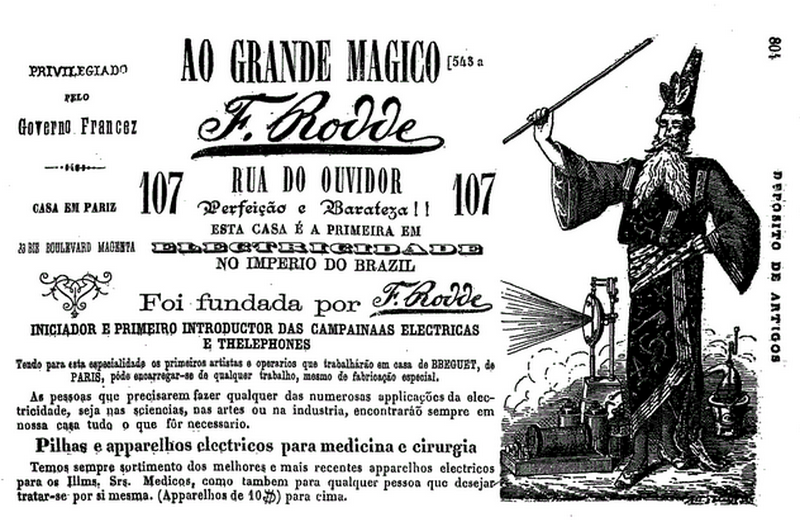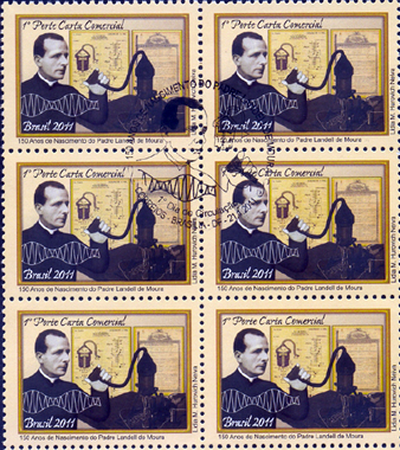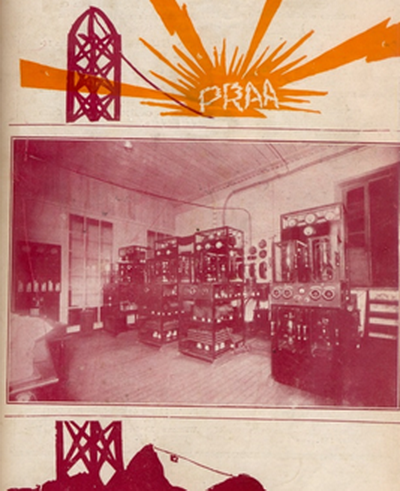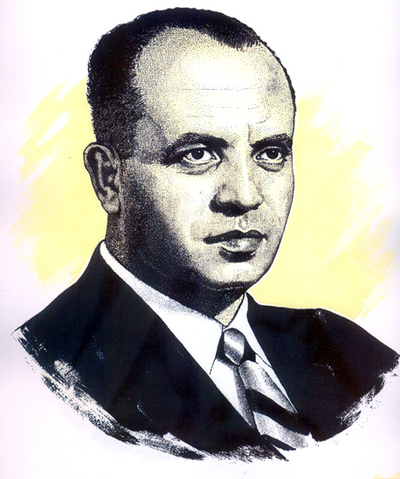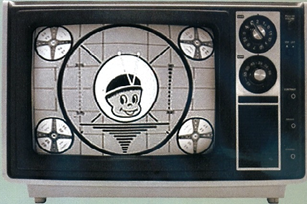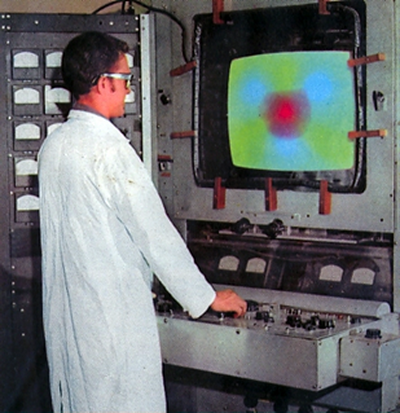DATE |
PARTICIPANT |
WORK |
RELEATED HISTORICAL EVENT |
1792 |
Brazilian Army |
The beginning of Military engineering courses.
|
Joaquim José da Silva Xavier, as known as “Tiradentes, leading the revolution “Inconfidência Mineira” being hung. |
1809 |
Empire of Brazil |
The Optical Telegraph is installed. |
Napoleon married Maria Louisa from the Empire of Austria. |
1813 |
Baron of Mauá |
Irineu Evangelista de Souza was born in December 28th. Pioneer of Brazilian railroad and the transatlantic submarine cable.
|
1823 |
José Bonifácio |
Suggestion for demonstration of electricity to the Indians. |
Charles X reigning in France. |
1825 |
Emperor D. Pedro II |
Pedro Alcântara João Carlos Leopoldo Salvador Bibiano Francisco Xavier de Paula Leocádio Miguel Gabriel Rafael Gonzaga was born on December 2nd, in Rio de Janeiro.
|
France and Mexico in war. |
1825 |
Baron of Capanema |
Guilherme Shuch de Capanema was born on January 17th, in Rio de Janeiro. Pioneer of the Electrical Telegraph.
|
Ending of Independence processes in Spanish colonies in Central and South Americas. |
1851 |
Baron of Capanema and Polydoro Quintanilha |
First experimental electrical telegraph message sent.
|
Publication of the constitutions of Naples, Tuscany and Piedmont. |
1852 |
D. Pedro II |
Inauguration of the electrical telegraph.
|
1855 |
Repartição Geral dos Telégrafos(Telegraph Administration Department) |
Baron of Capanema is appointed general manager.
|
End of Crimea War. |
1857 |
Repartição Geral dos Telégrafos(Telegraph Administration Department)
|
Inauguration of second telegraph line joining the cities of Rio de Janeiro and Petropolis.
|
Flaubert published the book Madame Bovary. |
1860 |
Henri Charles Morize |
Born in December 31st. Forerunner of the Brazilian broadcasting system.
|
Lenoir develops the internal combustion engine. |
1861 |
Roberto Landell de Moura |
Born in January 21st. Forerunner of radio telephony.
|
Paraguay war |
1865 |
Repartição Geral dos Telégrafos |
Telegraph training rules and local production of lightning rods in Brazil.
|
1866 |
Repartição Geral dos Telégrafos(Telegraph Administration Department) |
First long distance telegraphic line joining the cities of Rio de Janeiro and Porto Alegre.
|
1869 |
Repartição Geral dos Telégrafos(Telegraph Administration Department) |
Local manufacturing of the first telegraphic apparatus.
|
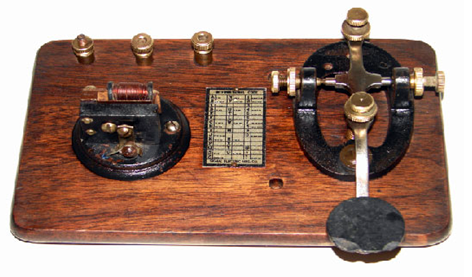
In 1852, the electric telegraph is officially installed in Brazil. The demand for skilled personnel in a typical agricultural country required a herculean effort of Baron of Capanema, responsible for organizing the Brazilian telegraphic system, led to the foundation of the first school of telegraphy in the country. In the illustration an early telegraph key used for telegrapher training purpose. |
|
1871 |
Arthur Rudolph Berthold Wehnet |
Born in April 4th in Rio de Janeiro. Pioneer of the Thermionic science.
|
Law of free birth is proclaimed in Brazil. |
1872 |
Baron of Mauá |
Granted permission to operate the transatlantic telegraphic submarine cable.
|
Giuseppe Verdi opens the opera La Traviata. |
1873 |
Baron of Capanema |
The British Patent Office grants patent nº 4171 on a telegraphic line insulating device.
|
The first Spanish Republic is proclaimed. |
Brazilian Submarine Telegraph Co. Ltd. |
Decree grants permission to operate the transatlantic telegraphic submarine cable.
|
Empresa Montevidean and Brazilian Telegraph(Montevidean and Brazilian Telegraph Company)
|
The cities of Rio Grande (RS) and Rio Chuyi are joined by telegraphic lines.
|
Empresa Platino-Brasileira
(Platino-Brasileira Company)
|
The cities of Rio de Janeiro and Buenos Ayres are joined by telegraphic lines.
|
1874 |
D. Pedro II |
Inauguration of the transatlantic submarine cable by sending the first message to several Europeans countries.
|
The Labor Socialist Party is found in Germany. |
Western Brazilian Telegaph Co. |
The Brazilian Federation States of Bahia, Pernambuco and Para a joined by the coastal submarine cable on January 1st.
|
Western Brazilian Telegraph Co. |
The city of Recife is joined to Portugal by the transatlantic submarine cable on June 22nd.
|
| 1876 |
D. Pedro II |
A.G. Bell demonstrates the telephone to the emperor D. Pedro II at “Philadelphia Centennial Exposition”. |
Foundation of the German Empire |
| 1876 |
Lívio Gomes Moreira |
Born in 1876. Brazilian forerunner of telegraphy, radio telegraphy and radio broadcasting. |
1877 |
Antonio Ribeiro Chaves |
Made the first telephone apparatus in Brazil as known as “telephonios”.
|
Thomas Alva Edison announces the invention of the phonograph. |
----------------- |
The first telephone line in Rio de Janeiro joining a commercial shop and the city firefighters headquarter.
|
Rodde & Company |
Set a telephone line joining the Company offices and Rio de Janeiro’s stock market.
|
1881 |
----------------- |
Publication of the first telephone book.
|
Czar Alexander II is murdered. |
Telephone Company of Brazil. |
The Decree nº 8065 grants permission to operate in Brazil.
|
1884 |
Edgard Roquette Pinto |
Born on January 25th in Rio de Janeiro. In September 23rd, 1923 found the first Brazilian radio station, “Radio Sociedade do Rio de Janeiro”, Call SQ1A. He is considered the patron of the Brazilian broadcasting system.
|
Conference of Berlin on the partition of Africa. |
1890 |
Brazilian Government |
The Decree nº 372-A proclaims that the Brazilian telegraphic and telephone systems are federal properties providing services for of the government and general private citizens.
|
Pope Leo XIII proclaims the encyclical Catholicae Ecclesiae, on the abolition of slavery. |
|
Who invented radio? It is a quite difficult answer due to the complex interwoven involvement of several scientific, technical, historical and even litigation on patent infringements based in the work of so many researchers like: James Clerck Maxell, David Hughes, J.C. Bose, Heinrich Hertz, Oliver Lodge, Alexander Popov, Guglielmo Marconi, Nikola Tesla, Reginald A. Fessenden, Lee De Forest and certainly of the Brazilian Roberto Landell de Moura.
Father Landell de Moura, as he preferred to be called, was a Brazilian wireless pioneer as on June 3rd, 1900, he demonstrated his wireless speech transmitting equipment in São Paulo city, Brazil.
A man out the time he was granted with a Brazilian patent, nº 3729, as well as after an intensive work conducted under his own expenses in the USA, led the US Patent Office in 1902/03 awarded him three patents: 775337, 775846 and 77917 respectively for his wireless telephone, wireless telegraph and on a wave transmitter. For more information on the subject please refer to James P. Rybak’s article published in the Antique Wireless Association journal, formerly Old Timer’s Bulletin, February 2002, USA.
Even considering his advanced ideas for a reliable wireless transmission of the speech he faced innumerous technical, lack of funds and political difficulties to find prospective possibilities to revert his patents for commercial application purposes.
In the meantime another two Brazilians, Jose Ildefonso de Oliveira and Agenor Queiroz working in Sorocaba, a nearby city of São Paulo faced similar difficulties as found by Landell de Moura since considering the unknown nature of the experiments they were forced by the local police to interrupt their work for the wireless transmission of the electrical signals.
Nevertheless as a forerunner of modern Radio Telephony – the wireless transmission of speech – he had his ideas spread all over the world since the miracle of radio as a consequence of the interleaved mass of strands due to the continuous incremental steps of sudden enlightenment of startling discoveries it was possible in 1918 only, when Frank Conrad working at the Westinghouse laboratory joined together the microphone and the thermionic valve opening to the world the first radio station – KDKA - given birth of the broadcasting as known as today.
Thus, since his famous public experiments Fr. Landell de Moura set a place in the hall of radio’s men of science. Therefore as the so long claimed just right homage to a true native radio pioneer, the Brazilian government through the country Post Office has issued a stamp commemorating the 150 years of the birth of Roberto Landell de Moura in last January 21st 2011. |
|
1895 |
Lívio Gomes Moreira |
Admittance into the Telegraph Administration Department.
|
José Marti is murdered in Cuba. |
1889 |
Brazilianische Electricitats GE-Sellschaft |
Brazilian government granted permission to operate in Brazil. Originally merged from the Companies Siemens & Halske, Alberto Frend & Co., e Theodore Willy & Co. stay in the market up to 1907 when its assets are purchased by Rio de Janeiro Tramway, Light and Power Co.
|
Brazilian republic is proclaimed. |
Baron of Mauá |
|
1889 |
Elba Dias |
Born in April 21st. Founder of the Brazilian magazine “Antenna”. One of the first publications on radio matters ever published in Brazil.
|
1900 |
Roberto Landell de Moura |
In São Paulo he demonstrates his invention on the wireless transmission of the voice in a distance of 8 km.
|
The Austrian neurologist Sigmund Freud publishes his work on the interpretation of the dreams. |
1901 |
Paulo Machado de Carvalho |
Born on November 9th in São Paulo. One of the most respected Brazilian radio and television broadcasting entrepreneurs.
|
Death of Queen Victoria in England. |
Roberto Landell de Moura |
Brazilian Patent Office issues patent under nº 3729 for his inventions named as: “tellegostom” e “teleauxiophone”.
|
1902 |
Government of the Brazilian Federation States of Amazonas and Para |
To improve researching and investment in wireless telegraphy, Government granted permission for Companies to operate throughout the inhospitable areas of the rivers Tocantins, Purus, Madeira e Amazonas.
|
Alfonse XIII is proclaimed king of Spain. |
1903 |
Repartição Geral dos Telégrafos (Telegraph Administration Department)
|
Beginning of radiotelephony experiments in Brazil.
|
The vaccine rebellion ocurred in Rio de Janeiro was a civil disorder against Government sanitary police aggravated by the bad people life quality. |
Francisco Bhering |
As the manager of The Telegraph Administration Department, he starts his technical training on Radio Telegraphy in the Europeans Companies: Ducretet-Branly e Algemeine Elektricitats Gesellschaft.
|
1904 |
Roberto Landell de Moura |
The United States Patent Office issues the patents under nº: 775.337– 775.846 and 771.917.
|
Russia is defeated by Japan. |
1904 |
Roberto Pisani Marinho |
Born in December 3rd. A renowned Brazilian entrepreneur leading a big broadcasting and newspapers chain. In 1965 found the largest Brazilian TV network – “Rede Globo de Televisão”.
|
1906 |
Marinha do Brasil (Brazilian Navy)
|
During a technical mission to test the wireless telegraphic signals transmitting/receiving quality, the warship “Aquidabã” suffered an severe explosion in her powder magazine killing circa 100 seamen.
|
Breakup of the Swedish-Norwegian Union. |
1907 |
Marinha do Brasil (Brazilian Navy)
|
The Navy Radiotelegraphic Department is found – S.R.M.
|
Nicaragua-Honduras war. |
1909 |
Lívio Gomes Moreira |
Introduced an innovative alphabetical keyboard to be used in the telegraphic apparatus made by the French maker “Baudot”.
|
Peary expedition to North Pole. |
Lívio Gomes Moreira |
The first two kilometers ranging radiotelegraphic transmission among Brazilian Radio Amateurs.
|
1912 |
Brazilian Government |
Beginning of the installation of the telegraphic signal time stations in the country. The first transmitting stations were transmitting from Fernando de Noronha, Barra do Rio Grande and São Tomé.
|
In the USA H.Ford announces the production of low cost automobile. |
Lívio Gomes Moreira |
At the Babilonia telegraphic station set an innovative experiment by using the first local made wireless radio detector transmitting/receiving signals to ships anchored in Rio de Janeiro bay.
|
1915 |
Olavo Bastos Freire |
Born in December 29th in Leopoldina, MG. Brazilian pioneer in electronics and television.
|
First WWI. |
1918 |
Lívio Gomes Moreira |
Published the book:Telegraphia – Noções Práticas.
|
1919 |
-------------------- |
Brazilian Radio Amateurs did the first experimental broadcasting transmission through the radio station “Radio Clube de Pernambuco”.
|
Versailles treaty is signed. |
1922 |
Brazilian Government |
The first broadcasting transmission in Brazil.
|
Centennial of Brazilian Independence. |
|
The first broadcasting radio transmission took place in Brazil on September 7th, 1922 through the transmitters of Radio Sociedade do Rio de Janeiro, Call SQ1A, originally found by Dr. Edgard Roquette Pinto and several collaborators. The illustration is a graphic arrangement made by the editor of the magazine “Radio Phono”, 1930 edition, displacing the new radio station Call, PRAA.
Source: Magazine Radio Phono. |
|
1923 |
Edgard Roquette Pinto and Henrique Morize |
The broadcasting radio station “Rádio Sociedade do Rio de Janeiro”, Call SQ1A is found.
|
Calvin Coolidge is elected president of the United States of America. |
Edgard Roquette Pinto |
On October 15th is released the first edition of the magazine “Radio”. The first Brazilian publication devoted to the Radio Science.
|
1924 |
Philips do Brasil |
The Dutch Company starts its activities in Rio de Janeiro.
|
Thomas Mann published the book The Magic Mountain. |
Brasilian Army |
The Military French Mission found the Army Transmission Training Center.
|
1928 |
Roberto Landell de Moura |
Death in June 30th in Porto Alegre, RS.
|
Guatemala proclaims the new country constitution setting the universal suffrage. |
1929 |
Victor Carone |
Experimental radio broadcasting transmitter in Sorocaba.
|
Vatican City is found. |
Revista Rádio Cultura |
Responsible for the organization of the first radio and phonographic exhibition in Rio de Janeiro.
|
1930 |
Henri Charles Morize |
Death on March 19th, in Rio de Janeiro
|
Getúlio Vargas is elected presidente of Brazil. |
Senor Abravanel |
Born on December 12th in Rio de Janeiro. Self-made man in the television business in Brazil.
|
1933 |
Sociedade Técnica Paulista |
Geraldo Homem de Melo found the Company. During WWII supplies communication apparatus to the Brazilian Army and radio beacons to the Navy.
|
Adolf Hitler se torna chanceler na Alemanha. |
Jouber Wey e Diogenes d’Almeida Marins |
Rádio Sociedade de Sorocaba is found..
|
1934 |
Rádio Cynephon Brasileira S/A |
Originally incorporated as maker of movie and broadcasting transmitters; later on shortwave radios and crystal filters to the Navy.
|
Mao Tse Tung leading the communist troops start the march to China. |
1934 |
Brazilian Army |
The Army Telegraphic Shop is reorganized and named as Army Transmitting Apparatus Facilities located in Rio de Janeiro.
|
1935 |
Maya, Rebello & Cia. |
Antonio Maya Monteiro, Arlindo Rebello e Mario M. da Silva found the Company as maker of radio communication equipment to the Navy and Army Department.
|
Germany invades Rhineland. |
1939 |
Brazilian/German Government/Telefunken |
First exhibition on the state of the art of television organized by German Post Office Department sponsored by Departamento Nacional de Propaganda do Brasil. |
WWII |
1940 |
Olavo Bastos Freire |
By using the “Iconoscope” model 1847 builds an experimental video camera.
|
1942 |
Affonso Abrão Hennel |
”Sociedade Eletro Mercantil Paulista – SEMP”, is found in São Paulo as maker of radio receivers.
|
1943 |
Bernardo Kocubej |
“Indústria e Comércio de Rádios Invictus” is found being one of the first makers of radio and television receivers in Brazil.
|
1944 |
Instituto de Física da Universidade de São Paulo
(São Paulo University Physics Institute)
|
Dr. Marcelo Damy de Souza Santos e Paulus Aulus Pompeia develops the first underwater detection and tracking system for the Brazilian Navy.
|
1945 |
Eletrônica São Paulo |
Incorporated on August 5th, it was the first Company in South America to manufacture turntables supplied with phonograph cartridges by using “La Rochelle” crystal.
|
|
Bernardo Kocubej found his Company, “Indústria e Comércio de Rádios Invictus”, one of the first makers of radio receivers in Brazil. Kocubej was an innovator and a Brazilian entrepreneur in the electronic field by producing the first television receivers supplied with his own made kinescopes or image tubes.
Source: collection Golda Kocubej. |
|
1946 |
Eduardo Ferreira da Rocha |
Announces on of the first television system ever made in Brazil.
|
The constituint convention proclaims the 4th Brazilian constitution. |
1948 |
Olavo Bastos Freire |
An image DXing took place among a team of Brazilian Radio Amateurs in the city of Juiz de Fora, MG. The video signal transmitting side was under the supervision of Bastos Freire, Aloysio Cavalcante Albuquerque, Call PY4FI, Roberto Thielmnaan, Call PY4FQ while the receiving station was Homero Fontes, call PY4CB.
|
United Nation proclaims the Universal Declaration of Human Rights Declaration. |
Olavo Bastos Freire |
The first totally open circuit video signals transmission.
|
1949 |
Olavo Bastos Freire |
Builds a television set comprising the audio transmitter operating the frequency range 116, 8 MHz and 7 inches TV receiver provided with channel selector.
|
Soviets blockade West Berlin. |
1950 |
USP-Telecom |
Dr. Vladimir K. Zworykin, RCA vice-president and inventor of the “kinescope” and “iconoscope” visits São Paulo city under the sponsoring of São Paulo University, Engineering Institute and São Paulo Association of Radio Broadcasting Stations.
|
Russia and China signs the friendship agreement. |
Diários Associados - Assis Chateaubriand |
The first open-circuit black-white television transmission in Brazil took place on September 18th through TV Tupi, channel 3, Call PRF-3.
|
|
Mario Fanucchi, graphical designer responsible for vignette production at “TV Tupi” network, created a stylized TV test pattern like a small Indian which was on the air in the beginning of the PRF-3 transmissions. Soon christened as the small Indian “Tupiniquim”, the new cartoon in childlike style display its plume with antennas arising a pleasant look mainly for the infantile audition besides binding a new marketing identity to the station, already known as responsible to bring the television technology to Brazil.
Source: Fonte: - Book: "The Voice of the Electrical and Electronics Industry in Brazil", ABINEE, São Paulo, 2008. |
|
1951 |
Diários Associados – Assis Chateaubriand |
TV Tupi Canal 6, Call PRG3-TV is inaugurated in Rio de Janeiro.
|
The European Coal and Steel Commonwealth found in Paris. The forerunner instituition of the nowaday European Communities. |
1951 |
Sociedade Nacional de Eletrônica - SNE |
José Barros Santos e Anteneu Leuenroth found the Company as maker of AM and FM broadcasting radio transmitters.
|
1953 |
Philips–IBRAPRE - Indústria Brasileira de Produtos Eletrônicos. |
Announce to the Press the project to start the manufacturing of thermionic valves in Brazil.
|
Corea war ended. |
INBELSA-Philips |
Originally as Cacique S/A merged into the Philips-Ibrap group making broadcasting and military communication equipment
|
1954 |
Edgard Roquette Pinto |
|
Indochina partition: Laos, Cambodia and Vietnam. |
Whinner Indústria e Comércio S/A |
In 1975 starts the production of communication equipment for the Brazilian Armed Forces as antennas and “ADF” (Automatic Direction Finding).
|
Olavo Bastos Freire |
Develops project for an automatic voltage regulator.
|
Associação Brasileira de Telecomunicações |
First Brazilian exhibition on radio, television electronics and communication in Rio de Janeiro.
|
1955 |
Philips - IBRAPE – Indústria Brasileira de Produtos Eletrônicos |
Beginning of thermionic valve production in Brazil.
|
Juan Domingos Peron is deposed in Argentina. |
RCA Victor Radio S/A |
Announce the production of thermionic valves, kinescopes and solid-states devices in Brazil.
|
Indeletron S/A – Indústria Eletrônica |
João Batista Faria found the Company for producing SSB for Brazilian Post Office Department and the Army.
|
Sabre S/A – Brasileira de Rádio Emissão |
Incorporated as maker of military communication equipment for operation in VHF band, frequency range, 30 – 300 MHz
|
1956 |
RCA Victor Radio S/A |
Starting the production of thermionic valve in the new Company plant located in Contagem, MG.
|
Juscelino Kubitschek is elected president of Brazil. |
Beginning of the production of black-white kinescopes.
|
1957 |
Rede Record
(Record Radio and TV Network)
|
“TV Record” in São Paulo and “TV Rio” in Rio de Janeiro are linked for the first interstate telecommunication network transmitting famous horse racing from Gavea’s hippodrome.
|
Soviet Union launches the first manmade satellite - Sputnik. |
1959 |
Luiz Carlos Miele |
The video tape machine was used for the first time during the inauguration of the TV station, “TV Continental”, assigned as channel 9 in Rio de Janeiro. The TV station starts transmitting on June 30th at 09, 00 PM while originally the telecasting, presented by Luiz Carlos Miele, was recorded in the same day afternoon.
|
Canada and the USA open the Saint Lawrence seaway. |
1960 |
MicroLab Eletrônica S/A |
Company devoted for developing special electronic projects for the Brazilian Navy comprising, receiver operating in the frequency range 3- 30 MHz, UHF transmitters/receivers as well as frequency meters and synthesizers.
|
The researchers Walsh and Piccard, by using the bathyscaphe “Trieste” explore the deepest part of the world's ocean and the deepest location on the surface of the Earth's crust, the Challenger deep in the Mariana Trench. |
Diários Associados – Assis Chateaubriand |
Brasilia, the new capitol of Brazil was inaugurated in April 21st. The commerations were transmitted by “TV Tupi” by using several aircrafts as video and audio signal repeaters.
|
Philco Rádio e Televisão Ltda. |
Launching in the Brazilian Market an innovative the television receiver as known as “Predicta”.
|
Indústria de Rádio e Televisão Menandro Creazola Ltda |
Company found as maker of portable electrical Victrola, radio and television receivers. The Company’s larger models, by using 23” kinescopes were already supplied with cassette tape recorders.
|
1962 |
Brazilian Government |
The law 4117 proclaims the Brazilian Telecommunication Code, the Brazilian Telecommunication Council – CONTEL, as well as the National Telecommunication Fund.
|
Cuban Missile Crisis. |
1963 |
Brazilian Government |
The National Telecommunication Plan is proclaimed by the Decree nº 52.859.
|
Malasia Federation is proclaimed. |
1964 |
Sylvania Produtos Elétricos |
Celebrates the manufacture in Brazil of the 500,000th kinescope.
|
Eduardo Frei is elected president of Chile. |
1965 |
Brazilian Government |
Brazi joins to International Telecommunications Satellite Organization (INTELSAT).
|
The Brazilian president João Goulart is deposed. |
ABC Rádio e Televisão do Nordeste |
Branch factory is found in the Northern area of Brazil.
|
1967 |
Brazilian Government |
The Decree nº 288 settles The Free Economic Zone of Manaus.
|
South Africa is performed the world's first successful human-to-human heart transplant. |
1968 |
Assis Chateaubriand |
The mogul of radio, television and general media dies in São Paulo on April 4th.
|
In Paris the beginning of conversation to cease the Vietnam war. |
1969 |
Elba Dias |
|
The American astronaut Neil Armstrong walks on the Moon. |
1970 |
Ministério das Comunicações(Brazilian Department of Communications)
|
Long distance telephone dialing system connecting the cities of São Paulo and Porto Alegre.
|
Salvador Allende is elected president of Chile. |
Olavo Bastos Freire |
Develops slow-scanning television transmission system devoted to radio amateurs.
|
Colorado Radio e Televisão S/A |
The Company is found as makers of radios, and television receivers.
|
1972 |
Brazilian Government |
Officially on February 19th, in Caixas do Sul, (RS) the first colored image transmission in Brazil is carried on by the several TV stations: “TV Difusora”, “TV Rio”, “TV Piratini” e “TV Caxias".
|
USA and Soviet Union signed the first Treaty on the Non-Proliferation of Nuclear Weapons . |
|
Sylvania Produtos Elétricos starts the colored kinescope-making in Brazil at his facilities located in São Paulo. A painstaking manufacture process comprises several steps of industrial sequential stages and certainly, including an accurate quality-control to check the component’s electrical performance as well as operational condition regarding the vacuum and luminosity level and finally the quality of the image projected by the cathode.
Source: Antenna Magazine. |
|
1973 |
Jose Luiz Guanarys Rego |
Working at the laboratory of the Company Cobra S/A developed the first local made computer, model G-10.
|
The US Department of Defense brings up the Internet protocol. |
1975 |
Embratel |
Brings up the international long distance direct telephone dialing system.
|
The communist seize Cambodia. |
1980 |
Bernardo Kocubej |
The pioneer of the Brazilian electronic industry passed way in São Paulo.
|
Beginning of the Iran-Irak war. |
1986 |
Ministério das Comunicações
(Brazilian Communciation Department) |
Through the administrative directive nº 243 the government grants permission for the Brazilian radio and television broadcasting to use the multiplexing audio transmission system – the stereophonic television.
|
The catastrophic nuclear accident occurs in the Chernobyl Nuclear power Plant in Ukraine. |
1992 |
Paulo Machado de Carvalho |
Death on March 7th, in São Paulo.
|
Maastricht Treaty undertaken to integrate Europe. |
2003 |
Roberto Pisani Marinho |
Death at the age of 98 year old on August 3rd in Rio de Janeiro.
|
Human Genome Project was declared complete. |
